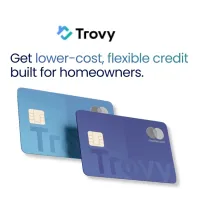A New Kind of HELOC Lets Homeowners Fund Remodels on Their Terms
Finance home upgrades gradually, using the equity you already have.


Anyone who’s tackled a home remodel knows costs can snowball fast, and today’s prices for materials, labor and financing don’t make it any easier. While mortgage rates have cooled slightly from their 2023 peak, many homeowners are still reluctant to refinance and lose their low rates.
That has sparked a new question: How can you fund a remodel without touching your first mortgage or maxing out credit cards?
Rather than relying on a traditional loan with fixed draws and paperwork-heavy funding, a growing number of lenders now offer flexible, card-based home equity lines of credit (HELOCs) that let homeowners tap their home’s value as needed. These hybrid products work much like a credit card, offering swipe access or digital transfers but with interest rates tied to home-equity lending rather than high-rate consumer credit.
From just $107.88 $24.99 for Kiplinger Personal Finance
Become a smarter, better informed investor. Subscribe from just $107.88 $24.99, plus get up to 4 Special Issues

Sign up for Kiplinger’s Free Newsletters
Profit and prosper with the best of expert advice on investing, taxes, retirement, personal finance and more - straight to your e-mail.
Profit and prosper with the best of expert advice - straight to your e-mail.
Why homeowners are looking beyond traditional HELOCs
A standard home equity line of credit (HELOC) remains one of the most common ways to fund a home remodel. It offers a revolving line of credit secured by your home’s equity, typically with variable interest rates that are lower than most personal loans or credit cards.
But traditional HELOCs can feel rigid. Lenders often require a minimum draw amount, charge setup fees or impose strict repayment schedules. That’s where Trovy and similar platforms come in.
They combine the lower-rate borrowing power of a HELOC with the convenience and accessibility of a credit card. Instead of completing multiple forms and waiting for funds to transfer to a bank account, approved borrowers receive a Trovy card linked directly to their home-equity line.
With it, homeowners can pay contractors, purchase materials or move funds online, drawing only what they need, when they need it.
How a home-equity-backed card like Trovy works
Trovy’s model is designed for homeowners with built-up equity who want to finance projects gradually. You start by applying online, providing property details and verifying income and credit. Once approved, your line of credit is secured by your home but you don’t have to borrow a lump sum right away.
Instead, Trovy issues a HELOC card that functions like a credit card. You can use it for materials, appliances, contractor invoices and other purchases related to your renovation.
Because it’s tied to your home equity, the interest rate will likely be lower than a standard credit card. Trovy lists variable APRs in the 6% to 12% range, depending on your credit profile and available equity.
Other notable features:
- No minimum draw requirement. You only pay interest on what you use.
- No annual or closing fees. Trovy eliminates several costs that can make traditional HELOCs less appealing.
- Flexible repayment. Borrowers can pay down balances at any time without penalty.
- Tax-deductible interest. When funds are used for qualified home improvements, the interest may be deductible under IRS rules.
With a Trovy HELOC Card, your home's equity is in your wallet.
The Trovy HELOC card is linked to your home’s equity, giving homeowners flexible access to funds without an upfront draw. Borrow up to 85% of your home’s equity when needed, with no origination fees.
For homeowners managing multi-phase projects, say, a kitchen update now and a bathroom overhaul six months later, this flexibility can be a game-changer.
Real-world example: A remodel paid as it happens
Imagine a homeowner planning a $75,000 kitchen remodel. Rather than taking out a lump-sum home equity loan or depleting savings, they open a $100,000 Trovy line of credit. During construction, they use the Trovy card to pay a contractor’s $20,000 deposit and later buy $15,000 worth of appliances.
Because they’ve only drawn $35,000 so far, they pay interest on that amount, not on the full $100,000 line of credit. When phase two begins months later, they can use the same line to cover additional costs. This approach keeps cash flow flexible and helps avoid paying interest on unused funds.
It’s a modern take on the HELOC, built for how most renovations actually unfold one invoice, delivery or supply run at a time.
How Trovy compares to other funding options
The main advantage of a Trovy HELOC card is control. You can access your home’s value at lower rates than credit cards, but without the commitment of a lump-sum loan.
The trade-off is that, like any HELOC, your home is collateral. Missing payments could affect your credit or, in some cases, lead to foreclosure.
Feature | Traditional HELOC | Home Equity Loan | Personal Loan | Trovy HELOC Card |
Upfront draw | Often required | Lump sum | Lump sum | Use as needed, no minimum |
Access to funds | Checks or bank transfer | Direct deposit | Deposit | Card + digital transfer |
Annual fees | Sometimes | Sometimes | None | None |
Tax-deductible interest | Often | Often | Rarely | Yes, if used for home improvement |
When Trovy makes sense and when it doesn’t
A home-equity-backed card is best suited for homeowners who:
- Have significant equity (at least 20%) and good credit.
- Prefer incremental funding over a single lump sum.
- Want a lower-interest alternative to credit cards for big-ticket home upgrades.
- Plan to deduct interest for qualifying renovations.
It may not be ideal if you:
- Don't have good credit.
- Don’t have enough equity.
- Prefer not to secure a credit line with your home.
The future of home-equity access
For homeowners who want to remodel without refinancing or racking up high-interest debt, Trovy’s home-equity-backed card offers a middle ground. You borrow only what you need, and enjoy rates below typical credit cards.
It’s not a one-size-fits-all solution, and borrowers should compare costs and read the fine print. But as more homeowners look for flexible ways to use their built-up equity amid high renovation costs, Trovy’s model offers a modern option in home-improvement financing.
Related Content
Profit and prosper with the best of Kiplinger's advice on investing, taxes, retirement, personal finance and much more. Delivered daily. Enter your email in the box and click Sign Me Up.

Carla Ayers joined Kiplinger in 2024 as the eCommerce and Personal Finance Editor. Her professional background spans both commercial and residential real estate, enriching her writing with firsthand industry insights.
Carla has worked as a personal finance and real estate writer for Rocket Mortgage, Inman and other industry publications.
She is passionate about making complex real estate and financial topics accessible to all readers. Dedicated to transparency and clarity, her ultimate goal is to help her audience make informed and confident decisions in their financial pursuits.
